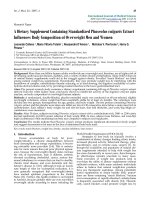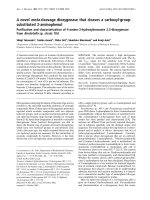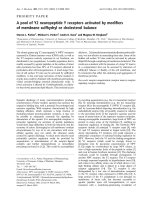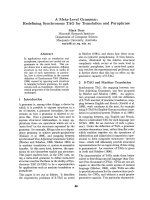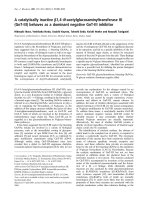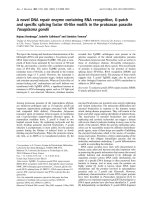Báo cáo y học: " A multiplex reverse transcription-nested polymerase chain reaction for detection and differentiation of wild-type and vaccine strains of canine distemper virus" pptx
Bạn đang xem bản rút gọn của tài liệu. Xem và tải ngay bản đầy đủ của tài liệu tại đây (488.42 KB, 6 trang )
Si et al. Virology Journal 2010, 7:86
/>Open Access
SHORT REPORT
BioMed Central
© 2010 Si et al; licensee BioMed Central Ltd. This is an Open Access article distributed under the terms of the Creative Commons Attri-
bution License ( which permits unrestricted use, distribution, and reproduction in any
medium, provided the original work is properly cited.
Short report
A multiplex reverse transcription-nested
polymerase chain reaction for detection and
differentiation of wild-type and vaccine strains of
canine distemper virus
Wei Si
†1
, Shun Zhou
†2
, Zhao Wang
2
and Shang-jin Cui*
1
Abstract
A multiplex reverse transcription-nested polymerase chain reaction (RT-nPCR) method was developed for the
detection and differentiation of wild-type and vaccine strains of canine distemper virus (CDV). A pair of primers (P1
and P4) specific for CDV corresponding to the highly conserved region of the CDV genome were used as a common
primer pair in the first-round PCR of the nested PCR. Primers P2 specific for CDV wild-type strains, were used as the
forward primer together with the common reverse primer P4 in the second round of nested PCR. Primers P3, P5
specific for CDV wild-type strain or vaccine strain, were used as the forward primer together with the common reverse
primer P4+P6 in the second round of nested PCR. A fragment of 177 bp was amplified from vaccine strain genomic
RNA, and a fragment of 247 bp from wild-type strain genomic RNA in the RT-nPCR, and two fragments of 247 bp and
177 bp were amplified from the mixed samples of vaccine and wild-type strains. No amplification was achieved for
uninfected cells, or cells infected with Newcastle disease virus (NDV), canine parvovirus (CPV), canine coronavirus
(CCV), rabies virus (RV), or canine adenovirus (CAV). The RT-nPCR method was used to detect 30 field samples
suspected of canine distemper from Heilongjiang and Jilin Provinces, and 51 samples in Shandong province. As a result
of 30 samples, were found to be wild-type-like, and 5 to be vaccine-strain-like. The RT-nPCR method can be used to
effectively detect and differentiate wild-type CDV-infected dogs from dogs vaccinated with CDV vaccine, and thus can
be used in clinical detection and epidemiological surveillance.
Introduction
Canine distemper (CD) is a highly contagious and fatal
disease of dogs caused by the canine distemper virus
(CDV), which is a single-stranded negative RNA virus
belonging to the Morbillivirus genus within the Paramyx-
oviridae family. Other members of the genus include
measles virus (MV) and rinderpest virus (RPV). The
genome of CDV is approximately 15,690 nucleotides (nt)
in length, containing several genes encoding N, P, M, F, H,
and L proteins. Only one serotype has been characterized
[1].
A large number of dogs, minks, foxes die from CDV
infections every year, causing significant economic
losses[2]. Previous studies[3,4] have reported that vacci-
nated dogs were infected with CDV in Europe and Japan.
Harder et al. also reported that there are marked differ-
ences between wild-type and vaccine strains of CDV[5],
thus whether CDV vaccine strains are able to provide
protection from the current strains of CDV remains a
question. It is difficult and necessary to discriminate
between wild-type and vaccine strains because the atten-
uated CDV vaccine is used widely in China. So a method
to specifically detect the wild-type CDV strains is neces-
sary. The multiplex reverse transcription-nested poly-
merase chain reaction (RT-nPCR) method could be used
to effectively detect and differentiate between wild-type
CDV-infected dogs from dogs which were vaccinated
with CDV vaccine, which would make it useful in clinical
diagnosis and epidemiological monitoring.
* Correspondence:
1
State Key Laboratory of Veterinary Biotechnology, Harbin Veterinary Research
Institute, Chinese Academy of Agricultural Sciences, Harbin, China
†
Contributed equally
Full list of author information is available at the end of the article
Si et al. Virology Journal 2010, 7:86
/>Page 2 of 6
Table 1: Age, sex, vaccination record, clinical form of distemper and diagnosis for dogs with naturally occurring
distemper
a
No origin sex age Vaccination
record
Clinical Form
of distemper
RT-nPCR
1 dog M 5 vacc C V-/W+
2 dog M 3 vacc C V+/W+
3 dog M 3 vacc C V-/W+
4 dog F 2 vacc C V+/W-
5 dog F 36 no N V-/W+
6 dog M 6 vacc C V-/W-
7 dog F 6 vacc S V+/W-
8 dog M 6 vacc S V-/W+
9 dog F 5 vacc C V-/W-
10 dog F 4 vacc C V+/W+
11 dog M 8 vacc C V+/W-
12 dog M 6 vacc C V-/W-
13 dog F 6 vacc C V+/W-
14 dog F 26 NI N V+/W-
15 dog F 5 vacc S V+/W-
16 dog M 3 vacc C V-/W-
17 dog M 3 vacc C V-/W-
18 dog M 9 NI S V+/W-
19 dog M 4 NI N V-/W-
20 dog F 4 no N V-/W+
21 dog F 3 no S V-/W+
22 dog F 3 no C V-/W-
23 dog F 6 no C V-/W-
24 dog F 6 no C V+/W-
25 dog M 2 no C V-/W+
26 dog M 2 no S V-/W-
27 dog F 2 no S V+/W-
28 dog M 3 no S V-/W-
29 dog M 4 no S V-/W-
30 dog M 3 no S V-/W+
31 dog F 4 no C V-/W-
32 raccoon F 5 vacc C V+/W+
33 raccoon F 3 vacc C V-/W-
34 raccoon F 3 vacc C V-/W+
35 raccoon F 5 vacc C V-/W+
36 raccoon M 5 vacc S V-/W-
37 raccoon M 5 vacc S V-/W+
38 raccoon M 5 vacc C V-/W-
39 raccoon F 4 vacc C V+/W-
40 raccoon F 4 vacc C V-/W+
41 raccoon F 4 vacc C V-/W-
Si et al. Virology Journal 2010, 7:86
/>Page 3 of 6
Study Design
With the help of Oligo6 software, six primers were
designed based on the genomic sequences of CDV strains
published in GenBank (CDV strains: Onderstepoort,
Convac, A75/17, Rorkborn, Snyder Hill, Lederle, et al).
Forward primers P1 (5'-AAATCCTGTGTTAC-
CCGCTC-3'), P2 (5'-TGGTGGCTCTGCAATATGAA-
3'), and P3 (5'-AATGAATGGATGCCTGGGGTTT-3')
were used as the primer specific for CDV species, wild-
type strains, and vaccine strain Onderstepoort, respec-
tively. Primer P4 (5'-ACGTCCTGGAC-
CCTAAGTTTTG-3') was used as a shared reverse
primer. P5(5'-GGTTTTATAAAAGATT), p6(5'-ATCTA-
GAGGTAA-3') were used as the primer specific for dif-
ferent CDV vaccine strains. Primer pairs P1/P4, P2/P4,
P3/P4 and P5/P6 were expected to generate a product of
600, 247, 177 bp and 177 bp, respectively. CDV vaccine
(CDV-A strain) and wild-type strains are maintained in
the Harbin Veterinary Research Institute. A total of 30
field samples (lung, spleen, liver, or bladder) were col-
lected from different farms in Heilongjiang and Jilin prov-
inces of China.
Multiplex reverse transcription-nested polymerase chain
reaction
Total RNA was extracted from the infected cells with
TRIzol
®
reagent in accordance with the manufacturer's
instructions. cDNA synthesis reaction was performed by
polymerase chain reaction as described elsewhere using
primer Moloney murine leukemia virus reverse tran-
scriptase (M-MLV RT)[6-10]. The first-round PCR was
performed with primers P1 and P4. A nested PCR was
performed in a total volume of 25 μL containing the first-
round PCR products diluted tenfold as well as each of
primers P2/P4, P3/P4, or P2, P3/P4[10-12]. The RT-nPCR
products were visualized by electrophoresis in a 2% (w/v)
agarose gel.
Specificity, sensitivity, and repeatability tests
RT-nPCR was used to detect the cells infected with CDV
vaccine strain, wild-type strain, mixed CDV vaccine and
wild-type strains, CPV, CAV, CCV, RV, NDV, and unin-
fected cells to test its specificity. Extracted RNA from
serially diluted (10
4
, 10
3
, 10
2
, 10
1
, 10
0
, 10
-1
, 10
-2
, 10
-3
TCID
50
) CDV cell cultures (10
6.5
TCID
50
/mL) were
assayed by RT-nPCR to determine its sensitivity. RT-
nPCR was performed to identify cells infected with CDV
vaccine strain, wild-type strain, mixed CDV vaccine and
wild-type strains, field samples from Heilongjiang and
Ji lin prov ince, C P V, C AV, CC V, RV, NDV, and unin fecte d
cells three times to validate the repeatability of the test.
30 samples in Heilongjiang and Jilin provinces, and
Fifty-one field samples from dogs, raccoons, foxes, and
minks in Shandong provinces were assayed by RT-nPCR;
the background of the 51 field samples is listed in table 1.
All the positive field samples wild-type strain were con-
firmed by Rapid test which BioNote, Inc. produced.
Phylogenetic analysis and detection of CDV in field
samples by RT-nPCR
Two of the field samples from Heilongjiang province were
selected for amplification of the H gene of CDV by RT-
PCR with primers P5 (5'-CCAATTCATCCAAGCT-
GTCC-3') and P6 (5'-GGGATTTGAACGGTTACAT-
GAG-3'). The amplified products were cloned and
sequenced, and the sequences were aligned with the H
genes of a number of CDV strains available in GenBank
using the MegAlign function of the DNAStar software
package. Thirty field samples from dogs, foxes, and rac-
coons in Heilongjiang and Jilin provinces were also
assayed by RT-nPCR.
42 fox F 3 vacc C V-/W-
43 fox M 3 vacc C V-/W+
44 fox M 5 vacc C V+/W+
45 fox M 6 vacc C V-/W+
46 fox M 6 vacc C V-/W+
47 mink F 3 vacc S V-/W-
48 mink F 4 vacc C V+/W-
49 mink F 5 vacc C V-/W+
50 mink M 5 vacc C V-/W-
51 mink M 3 vacc C V+/W-
a
Abbreviations: F, female; M, male; C, catarrhalic; S, systemic; N, nervous; V+, vaccine strain positive; W+ wild type positive; V-, vaccine strain
negative; W-, wild type negative
Table 1: Age, sex, vaccination record, clinical form of distemper and diagnosis for dogs with naturally occurring
distemper
a
(Continued)
Si et al. Virology Journal 2010, 7:86
/>Page 4 of 6
Results
Determination of the application conditions of the
multiplex RT-nPCR
After the application of the first-round PCR, primers P2
and P4, and P3, P4, P5 and P6 together, were used to
amplify the vaccine and wild-type strains, respectively, at
different anneal temperatures. According to the result,
when the anneal temperature was from 49-54°C, there
was only one specific band. Primers P2, P3, P4, P5 and P6
were used to perform RT-nPCR with different anneal
temperatures. Only one specific band was observed at an
anneal temperature from 49.5-54.5°C, with the most dis-
tinct band appearing at 51.5°C. Thus, 51.5°C was chosen
for the RT-nPCR.
Specificity of the multiplex RT-nPCR
A fragment of 247 and 177 bp was amplified from CDV
wild-type strain and the vaccine strain, respectively. Two
bands of 247 and 177 bp were detected simultaneously
from the mixed genomic RNA of the CDV wild-type and
vaccine strains. Amplification was not possible for non-
CDV viruses, such as CPV, CAV, CCV, RV, NDV-infected
cells, and uninfected cells by RT-nPCR (Fig. 1).
Sensitivity, applicability, and repeatability of the multiplex
RT-nPCR
Serial 10-fold dilutions of CDV vaccine strain were sub-
jected to amplification by multiplex RT-nPCR. The low-
est limit of detection with this method was shown to be
0.1 TCID
50
. Of the 30 field samples, 20 tested positive for
CDV, among which, 15 showed presence of wild-type
viruses, and 5 showed presence of vaccine strain. Three
independent inter- and intra-assay replicates of the multi-
plex RT-nPCR gave consistent results, indicating the
repeatability of the assay.
Phylogenetic analysis based on H gene
A phylogenetic tree based on the H genes of various CDV
strains was generated using the MegAlign of DNAStar
software. As shown in Fig. 2, the selected two samples
were grouped into wild-type viruses and belonged to a
genotype that is obviously different from the CDV vac-
cine strain.
Discussion
To date, CDV remains one of the most important canine
diseases worldwide. Surveillance represents a primary
concern in the control of CDV. In addition to traditional
methods using virus isolation, several promising antigen-
ELISA, AGP, and FA methods have been developed and
evaluated. However, these methods are laborious and
time consuming. Moreover, these tests cannot differenti-
ate CDV wild-type strains from vaccine strains[13,14].
With the recent availability of genomic sequences,
molecular diagnostic methods for detection of viruses
have significantly improved[15]. Complementary DNA
and RNA probes have been used to detect RNA and
mRNA of the CDV genome with improved specificity
and sensitivity[6,7]. Primers P1 and P4 (specific for CDV
and conserved among CDV species), primer P2 (specific
for CDV wild-type strain), and primer P3, P5 (specific for
CDV vaccine strain), were selected from the well-con-
served regions of the gene encoding matrix protein. A
fragment of 600 bp was consistently amplified by RT-PCR
with P1/P4 for either CDV vaccine strain or wild-type
strain. The nested PCR with P2/P4 generated a 247 bp
fragment only for the wild-type strain, while P3/P4, P5/
P6 generated a same 177 bp fragment only for the vaccine
strain, and both fragments could be amplified from the
mixture of CDV vaccine and wild-type strains. No ampli-
fication was obtained for NDV and other common canine
vir use s, such as CC V, CP V, CAV, RV, and uninfe cted cells
control, indicating the high specificity of the method. The
method was sensitive, in that it could detect as little as 0.1
TCID
50
of the virus. The selected two samples were clas-
sified into a branch which belongs to the wild-type strain,
but constituting a genotype different from that of CDV
vaccine strains, as revealed by phylogenetic analysis
based on the sequences of the H gene region, which is
believed to be the most reliable classification and genetic
typing. RT-nPCR was used to detect the 30 field samples
in Heilongjiang and Jilin provinces; 20 of the field samples
were CDV-positive, among which 15 were wild-type
strain, and 5 were vaccine strain.
Caideron et al [16] performed an extensive phyloge-
netic and molecular evolution analysis on complete
sequences of all CDV genes to assess the role of selection
and recombination in shaping viral genetic diversity and
driving the emergence of CDV in non-dog hosts. They
tested the specific hypothesis that molecular adaptation
Figure 1 Amplification of genomes of different easily infected ca-
nine viruses by multiplex reverse transcription-nested poly-
merase chain reaction. Lane 1: positive control of canine distemper
virus (CDV) vaccine strain; lane 2: positive control of CDV wild-type
strain; lane 3: uninfected cells control; lane M: DL2000 DNA Marker;
lane 4: canine parvovirus; lane 5: canine adenovirus; lane 6: canine cor-
onavirus; lane 7: rabies virus; lane 8: Newcastle disease virus.
Si et al. Virology Journal 2010, 7:86
/>Page 5 of 6
at known receptor-binding sites of the haemagglutinin
gene is associated with independent instances of the
spread of CDV to novel non-dog hosts in the wild. The
selected two samples isolated from dogs were classified
into a branch which belongs to the wild-type strain, but
constituting a genotype different from that of CDV vac-
cine strains, as revealed by phylogenetic analysis based on
the sequences of the H gene region, which is believed to
be the most reliable classification and genetic typing. RT-
nPCR was used to detect the 51 field samples in Shan-
dong provinces; 36 of the field samples were CDV-posi-
tive, among which 20 were wild-type strain, 16 were
vaccine strain, and 4 were co-infected by wild-type and
vaccine strains. In summary, the multiplex RT-nPCR
developed in this study is a highly specific and sensitive
assay for the rapid detection and differentiation of wild-
type and vaccine strains of CDV.
For lack of other vaccine strains except CDV Onderste-
poort strain, the primers P5 and P6 were designed, but
could not use in this time, however, much work needs to
be done before a conclusion that this method has an out-
standing performance with other CDV vaccine strains. In
summary, the multiplex RT-nPCR developed in this study
is a highly specific and sensitive assay for the rapid detec-
tion and differentiation of wild-type and vaccine strains
of CDV.
Competing interests
The authors declare that they have no competing interests.
Figure 2 Phylogenetic tree based on H gene sequences. GenBank accession numbers of the strains quoted are as follows: AC96I (AB212963), TN
(AY390347
), Hamamatsu (D85754), Tanuki (AB016776), Yanaka (D85755), KDK-1 (AB025271), giant panda (AF178038), Guizhou (AY359613), US89
(Z47764
), A92-6 (Z54166), A75-17 (AF164967), Dog Denmark (Z47761), Dog 91A (AF478544), Dog Turkey (AY093674), 5804-Han90 (X85000),
007LMT(AB212729
), Dog5B (AY297453), Dog26D (AB040766), Dog98-002 (AB025270), DogHM-3 (AB040767), Greenland (Z47760), Liu (AF172411),
Onderstepoort (AF378705
), Convac (Z35493), Snyder Hill (AF259552).
Si et al. Virology Journal 2010, 7:86
/>Page 6 of 6
Authors' contributions
WS, SZ, ZW carried out the experiments and wrote the manuscript. SC con-
ceived the studies and participated in experimental design and coordination.
All authors read and approved the final manuscript.
Acknowledgements
The study was partly supported by funds from the Chinese state National
Hightech R&D Program (863 Program-2007AA100606). We would like to thank
Dr Huaji Chou's help to revise the paper.
Author Details
1
State Key Laboratory of Veterinary Biotechnology, Harbin Veterinary Research
Institute, Chinese Academy of Agricultural Sciences, Harbin, China and
2
Qingdao Agricultural University, Qingdao 266109, China
References
1. Yin Z, Liu JH: Animal virology 2nd edition. Scientific Publishing House,
Beijing, China; 1997:757-762.
2. Loffler S, Lottspeich F, Lanza F, et al.: CD9, a tetraspan transmembrane
protein, renders cells susceptible to canine distemper virus. J Virol
1997, 71:42-49.
3. Blixenkrone-Moller M, Svansson V, Have P, et al.: Studies on
manifestations of canine distemper virus infection in an urban dog
population. Vet Microbiol 1993, 37:163-173.
4. Iwatsuki K, Miyashita N, Yoshida E, et al.: The nucleotide and predicted
amino acid sequence of the fusion protein of recent isolates of canine
distemper virus in Japan. J Vet Med Sci 1998, 60:381-385.
5. Harder TC, Kenter M, Vos H, et al.: Canine distemper virus from diseased
large felids: biological properties and polygenetic relationships. J Gen
Virol 1996, 77:397-405.
6. Applel MJ: Virus infections of carnivores. In Virus infections of vertebrates
Volume 1. Elsevier, New York, NY; 1987:371-378.
7. Applel MJ: Canine distemper virus infection and encephalitis in
javelinas. Arch Virol 1991, 119:147-152.
8. Demeter Z, Lakatos B, Palade EA, et al.: Genetic diversity of Hungarian
canine distemper virus strains. Vet Microbiol 2007, 122(3-4):258-69.
9. Jozwik A, Frymus T: Comparison of the immunofluorescence assay with
RT-PCR and nested PCR in the diagnosis of canine distemper. Vet Res
Commun 2005, 29:347-59.
10. Li JZ, He HB, Xia XZ, et al.: Establishment and application of reverse
transcription Polymerase chain reaction for diagnosis of canine
distemper virus. Chinese journal of virology J Virol 1999, 5:180-184.
11. Yeon-sil Shin: Detect the PBMC of CDV N gene with RT-PCR. Abroad
Veterinary 1997, 17:26-29.
12. Yong-Hwan Kim, Kyu-Woan Cho, Hwa-Young Youn, et al.: Detection of
canine distemper virus (CDV) through one step RT-PCR combined with
nested PCR. J Vet Sci 2001, 2:59-63.
13. Qiao GL, Xia XZ, Wang DL, et al.: Comparison of methods for detecting
CDV antibody. Chinese Journal of Veterinary Sci 1997, 17:26-29.
14. Xu ZP, Zhang DX, Xian SM, et al.: Development of diagnostic method of
canine distemper. Journal of Mountain Agriculture and Biology 2004,
23:78-82.
15. Demeter. Z, Lakatos B, Palade EA, Kozma T, Forgách EA, et al.: Genetic
diversity of Hungarian canine distemper virus strains. Veterinary
Microbiology 2007, 122:258-269.
16. Calderon MG, Remorini P, Periolo O, Iglesias M, Mattion N, La Torre J:
Detection by RT-PCR and genetic characterization of canine distemper
virus from vaccinated and non-vaccinated dogs in Argentina. Vet
Microbiol 2007, 125:341-9.
doi: 10.1186/1743-422X-7-86
Cite this article as: Si et al., A multiplex reverse transcription-nested poly-
merase chain reaction for detection and differentiation of wild-type and vac-
cine strains of canine distemper virus Virology Journal 2010, 7:86
Received: 28 January 2010 Accepted: 1 May 2010
Published: 1 May 2010
This article is available from: 2010 Si et al; licensee BioMed Central Ltd. This is an Open Access article distributed under the terms of the Creative Commons Attribution License ( ), which permits unrestricted use, distribution, and reproduction in any medium, provided the original work is properly cited.Virology Journal 2010, 7:86
